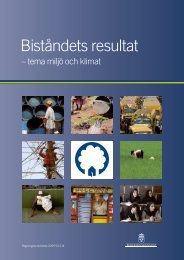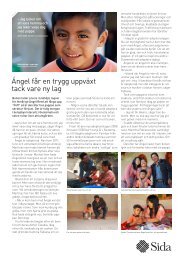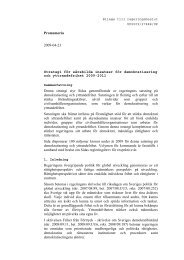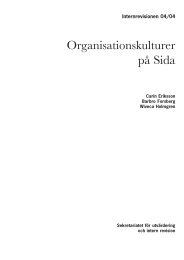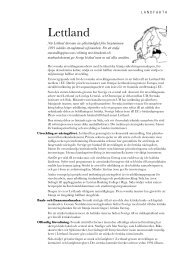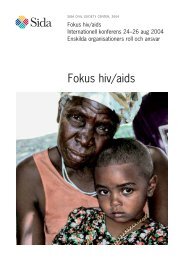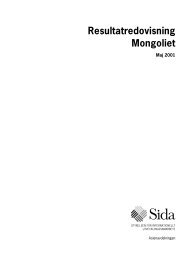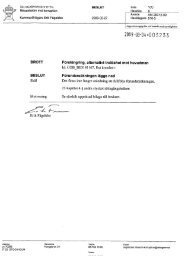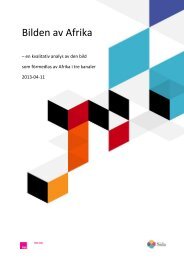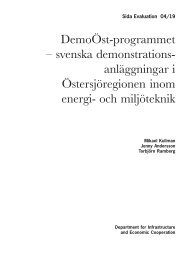Mobilisation of the Poor – a means to Poverty Reduction? - Sida
Mobilisation of the Poor – a means to Poverty Reduction? - Sida
Mobilisation of the Poor – a means to Poverty Reduction? - Sida
You also want an ePaper? Increase the reach of your titles
YUMPU automatically turns print PDFs into web optimized ePapers that Google loves.
ecorded from 1997 onwards, perhaps reflecting setbacks suffered by <strong>the</strong> programme as a result <strong>of</strong><br />
<strong>the</strong> termination <strong>of</strong> <strong>Sida</strong> support <strong>to</strong> <strong>the</strong> programme and <strong>the</strong> transfer <strong>of</strong> programme management<br />
from <strong>the</strong> RDTRI <strong>to</strong> <strong>the</strong> newly formed NGO. However, group funds, which do not correlate<br />
directly with fluctuations in membership, show a dramatic increase particularly from 1997<br />
onwards. It was not possible for us <strong>to</strong> validate this information in <strong>the</strong> field. Our inquires revealed<br />
that <strong>the</strong> reliability <strong>of</strong> this information may be low since it is based on information supplied by<br />
various CAP organisations <strong>to</strong> PSMS, which did not have any <strong>means</strong> <strong>to</strong> cross check this information<br />
in <strong>the</strong> field. Inconsistencies in <strong>the</strong> number <strong>of</strong> small groups, <strong>to</strong>tal membership, and volume <strong>of</strong> funds<br />
raises questions about <strong>the</strong> validity <strong>of</strong> <strong>the</strong> <strong>of</strong>ficial information. It is quite possible that <strong>the</strong> POs tended<br />
<strong>to</strong> over-report membership and volume <strong>of</strong> funds in order <strong>to</strong> qualify for grants or loans from <strong>the</strong><br />
national-level federation.<br />
We did obtain information from POs covered by <strong>the</strong> study about trends in membership in <strong>the</strong><br />
respective organisations, and this information base was also unreliable in some instances. Figure 1<br />
presents information from four POs where we did manage <strong>to</strong> get <strong>the</strong> relevant information.<br />
Trends in membership at PO Level<br />
Figure 1 presents information about trends in membership in selected POs.<br />
No <strong>of</strong> members<br />
Source: PO records and interviews with PO staff<br />
While some POs (for instance, Akmeemana and Nagoda) report a consistent rise in membership in<br />
CAP small groups over <strong>the</strong> 1995 <strong>to</strong> 2001 period, o<strong>the</strong>rs show a fluctuating trend with a marked<br />
decrease in membership from 1997 <strong>to</strong> 1999 and a subsequent trend <strong>to</strong>wards stabilisation <strong>of</strong><br />
membership in 2000<strong>–</strong>2001.<br />
In order <strong>to</strong> illustrate <strong>the</strong> processes involved, we present below case his<strong>to</strong>ries <strong>of</strong> two POs. It must be<br />
noted here that according <strong>to</strong> <strong>the</strong> evaluation scheme developed by <strong>the</strong> Maha Sangamaya, both <strong>the</strong><br />
POs under review are classified as moderately successful ones.<br />
22<br />
2000<br />
1500<br />
1000<br />
500<br />
0<br />
Trends in PS Membership 1995-2001<br />
1995 1996 1997 1998 1999 2000 2001<br />
Year<br />
MOBILISATION OF THE POOR <strong>–</strong> A MEANS TO POVERTY REDUCTION <strong>–</strong> <strong>Sida</strong> EVALUATION 02/08<br />
Ibbagam<br />
Gampola<br />
Akmeema<br />
Nagoda




